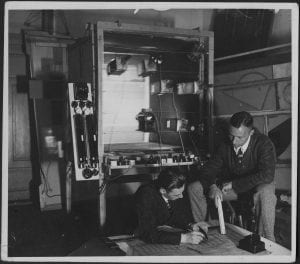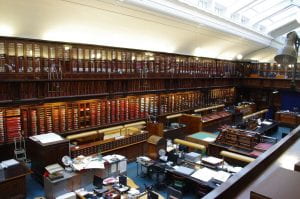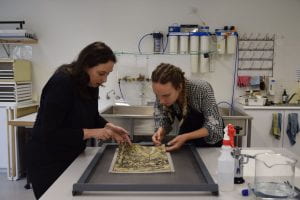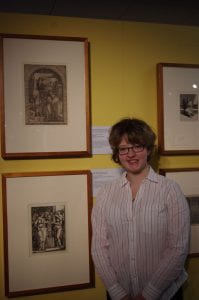Ludwig Hirschfeld-Mack and the Bauhaus

Jane Beattie, Assistant Archivist
Melinda Barrie, Archivist
Georgie Ward, Assistant Archivist
2019 marks the centenary anniversary of the opening of the Bauhaus Arts School in Berlin. Influenced by the 19th and early-20th-century artistic movements, the Bauhaus approach to teaching, and to the relationship between art, society, and technology, had a major impact around the world long after its closure under Nazi pressure in 1933.
Ludwig Hirschfeld-Mack delivered the first dedicated course on colour at the Bauhaus (as an unofficial course) in the winter semester of 1922-23, drawing on his life long fascination with the dynamic relationship between colour, movement and music. In his famous publication ‘The Bauhaus: An Introductory Survey’ Hirschfeld-Mack recalls how his own early interest in colour theory was inspired by the work of artists such as Paul Klee and Wasily Kandisky. He further describes the early experiments he conducted from 1922 to 1923 in the blending of primary colours and light which led to the development of his ‘Reflected Light Composition’ and ‘Colour Light Plays’. These early Bauhaus experiments later found expression in a didactic spinning top that demonstrated the optical mixing of colour upon a set of coloured plates. A model of the spinning top was produced for the opening of the Bauhaus Archive in Dramstadt, Germany in 1964, and later used in children’s education in Victoria, especially at the Kindergarten Teachers’ College in Kew.
Hirschfeld-Mack remained at the Bauhaus until 1926 and developed the “Farbenlichtspiele” (colour-light play), a further demonstration of the application of colour theory. Colour light plays were developed out of Hirschfeld-Mack’s experience in painting, and the need to turn the dynamic and rhythmic movements of colours into movement. Musical accompaniment heightened the experience. The plays were first performed at the Bauhaus Archive in Dramstadt in 1923, they were again performed in 1964 at the Archive when a film of the performance was made. The collection contains complete designs of the organ, as well as instructions for how to set up and use, and scores for the musical component.

After fleeing Germany to London in the lead up to World War Two, Hirschfeld-Mack was deported to Australia on the ship HMT Dunera in 1940 as an enemy alien. Despite internment in camps at Hay, Orange and Tatura , Hirschfeld-Mack continued producing artistic works and was eventually released through the efforts of Dr. James Darling. Hirschfeld-Mack was employed as art master at the Geelong Church of England Grammar School until his retirement in 1957, and taught at the University of Melbourne, the Council of Adult Education and elsewhere until 1965.
A heritage trail tracing Hirschfeld-Mack’s influence around the Geelong Grammar campus and further information about the art teacher known as “Hirsch” can be found on the school’s website.
The Ludwig Hirschfeld-Mack collection housed at UMA covers almost the whole period of Hirschfeld-Mack’s adult life, from photographs at teaching college in Dusseldorf to blueprints for the colour organ, to educational material and photographs of his students‘ artistic work at Geelong Grammar and correspondence with luminaries of the Bauhaus such as Wasily Kandisky, László Moholy-Nagy, and Josef Albers. Some correspondence, mostly between Hirschfeld-Mack and Hans Wingler, discusses destruction of the intellectual elite through the Nazis. Collection material is frequently used by students and academics alike for it’s deep research themes and comprehensive study of a fascinating life which has enriched the Australian art and educational landscapes.
To see the Ludwig Hirschfeld-Mack (1971.0009) collection listing visit the UMA catalogue.
Figure 1 – Spinning top and colour chart, Bauhaus exhibition 1961, Ludwig Hirschfeld-Mack Collection, 1971.0009.00007. Reproduced with permission.
Figure 2 – Ludwig Hirschfeld’s Macks’ Colour Light Projection Apparatus, 1923, Ludwig Hirschfeld-Mack Collection, 1971.0009.00013. Reproduced with permission.




